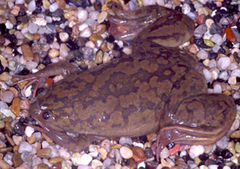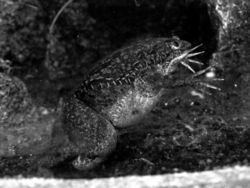African clawed frog
2007 Schools Wikipedia Selection. Related subjects: Insects, Reptiles and Fish
| iAfrican clawed frog | ||||||||||||||
|---|---|---|---|---|---|---|---|---|---|---|---|---|---|---|
 |
||||||||||||||
|
|
||||||||||||||
 Least Concern (LC) |
||||||||||||||
| Scientific classification | ||||||||||||||
|
||||||||||||||
|
|
||||||||||||||
| Xenopus laevis Daudin, 1802 |
The African clawed frog (Xenopus laevis, also known as platanna) is a species of South African aquatic frog of the genus Xenopus. It is up to 12 cm long with a flattened head and body but no tongue. Its name derives from its three short claws on each of its hind feet, which it probably uses to stir up mud to hide it from predators.
Although X. laevis is not blessed with the short generation time and genetic simplicity generally desired in genetic model organisms, it is an important model organism in developmental biology. X. laevis takes 1 to 2 years to reach sexual maturity and, like most of its genus, it is tetraploid. However, it does have a large and easily manipulable embryo. The ease of manipulation in amphibian embryos has given them an important place in both historical and modern developmental biology. A related species, Xenopus tropicalis, is now being promoted as a more viable model for genetics. Roger Wolcott Sperry used X. laevis for his famous experiments describing the development of the visual system. These experiments led to the formulation of the Chemoaffinity hypothesis.
Xenopus oocytes provide an important expression system for molecular biology. By injecting cDNA or cRNA into the developing oocyte, scientists can study the protein products in a controlled system. This allows rapid functional expression of manipulated cDNAs (or cRNA). This is particularly useful in electrophysiology, where the ease of recording from the oocyte makes expression of membrane channels attractive. One challenge of oocyte work is eliminating native proteins that might confound results, such as membrane channels native to the oocyte. Translation of proteins can be blocked or splicing of pre-mRNA can be modified by injection of Morpholino antisense oligos into the oocyte (for distribution throughout the embryo) or early embryo (for distribution only into daughter cells of the injected cell).
X. laevis is also notable as having been a standard method of pregnancy testing. Human chorionic gonadotropin is a hormone found in substantial quantities in the urine of pregnant women; when injected into the female X. laevis it induces them to lay eggs.
